C42 - Lewis Book Med Surg PDF

| Title | C42 - Lewis Book Med Surg |
|---|---|
| Author | Daisy Soloman |
| Course | Public Health Nursing |
| Institution | University of Utah |
| Pages | 18 |
| File Size | 253.3 KB |
| File Type | |
| Total Downloads | 8 |
| Total Views | 136 |
Summary
Lewis Book Med Surg...
Description
Chapter 42: Lower Gastrointestinal Problems Lewis: Medical-Surgical Nursing, 10th Edition MULTIPLE CHOICE 1. Which action will the nurse include in the plan of care for a patient who is being admitted
with Clostridium difficile? a. Teach the patient about proper food storage. b. Order a diet without dairy products for the patient. c. Place the patient in a private room on contact isolation. d. Teach the patient about why antibiotics will not be used. ANS: C
Because C. difficile is highly contagious, the patient should be placed in a private room, and contact precautions should be used. There is no need to restrict dairy products for this type of diarrhea. Metronidazole (Flagyl) is frequently used to treat C. difficile infections. Improper food handling and storage do not cause C. difficile. DIF: Cognitive Level: Apply (application) REF: 932 TOP: Nursing Process: Planning MSC: NCLEX: Safe and Effective Care Environment 2. A 74-yr-old male patient tells the nurse that growing old causes constipation so he has been
using a suppository for constipation every morning. Which action should the nurse take first? Encourage the patient to increase oral fluid intake. Question the patient about risk factors for constipation. Suggest that the patient increase intake of high-fiber foods. Teach the patient that a daily bowel movement is unnecessary.
a. b. c. d.
ANS: B
The nurse’s initial action should be further assessment of the patient for risk factors for constipation and for his usual bowel pattern. The other actions may be appropriate but will be based on the assessment. DIF: Cognitive Level: Analyze (analysis) REF: 933 OBJ: Special Questions: Prioritization TOP: Nursing Process: Implementation MSC: NCLEX: Physiological Integrity 3. A patient who has chronic constipation asks the nurse about the use of psyllium (Metamucil).
Which information will the nurse include in the response? Absorption of fat-soluble vitamins may be reduced by fiber-containing laxatives. Dietary sources of fiber should be eliminated to prevent excessive gas formation. Use of this type of laxative to prevent constipation does not cause adverse effects. Large amounts of fluid should be taken to prevent impaction or bowel obstruction.
a. b. c. d.
ANS: D
A high fluid intake is needed when patients are using bulk-forming laxatives to avoid worsening constipation. Although bulk-forming laxatives are generally safe, the nurse should emphasize the possibility of constipation or obstipation if inadequate fluid intake occurs. Although increased gas formation is likely to occur with increased dietary fiber, the patient should gradually increase dietary fiber and eventually may not need the psyllium. Fat-soluble vitamin absorption is blocked by stool softeners and lubricants, not by bulk-forming laxatives. DIF: Cognitive Level: Apply (application) REF: 935 TOP: Nursing Process: Implementation MSC: NCLEX: Physiological Integrity 4. A 26-yr-old woman is being evaluated for vomiting and abdominal pain. Which question from
the nurse will be most useful in determining the cause of the patient’s symptoms? a. “What type of foods do you eat?” b. “Is it possible that you are pregnant?” c. “Can you tell me more about the pain?” d. “What is your usual elimination pattern?” ANS: C
A complete description of the pain provides clues about the cause of the problem. Although the nurse should ask whether the patient is pregnant to determine whether the patient might have an ectopic pregnancy and before any radiology studies are done, this information is not the most useful in determining the cause of the pain. The usual diet and elimination patterns are less helpful in determining the reason for the patient’s symptoms. DIF: Cognitive Level: Analyze (analysis) REF: 939 TOP: Nursing Process: Assessment MSC: NCLEX: Physiological Integrity 5. A patient complains of gas pains and abdominal distention 2 days after a small bowel
resection. Which nursing action should the nurse take? a. Encourage the patient to ambulate. b. Instill a mineral oil retention enema. c. Administer the prescribed IV morphine sulfate. d. Offer the prescribed promethazine (Phenergan). ANS: A
Ambulation will improve peristalsis and help the patient eliminate flatus and reduce gas pain. A mineral oil retention enema is helpful for constipation with hard stool. A return-flow enema might be used to relieve persistent gas pains. Morphine will further reduce peristalsis. Promethazine is used as an antiemetic rather than to decrease gas pains or distention. DIF: Cognitive Level: Analyze (analysis) REF: 940 TOP: Nursing Process: Implementation MSC: NCLEX: Physiological Integrity 6. A 58-yr-old patient with blunt abdominal trauma from a motor vehicle crash undergoes
peritoneal lavage. If the lavage returns brown fecal drainage, which action will the nurse plan to take next? a. Auscultate the bowel sounds. b. Prepare the patient for surgery. c. Check the patient’s oral temperature. d. Obtain information about the accident. ANS: B
Return of brown drainage and fecal material suggests perforation of the bowel and the need for immediate surgery. Auscultation of bowel sounds, checking the temperature, and obtaining information about the accident are appropriate actions, but the priority is to prepare to send the patient for emergency surgery. DIF: Cognitive Level: Analyze (analysis) REF: 941 OBJ: Special Questions: Prioritization TOP: Nursing Process: Planning MSC: NCLEX: Physiological Integrity 7. A young adult patient is admitted to the hospital for evaluation of right lower quadrant
abdominal pain with nausea and vomiting. Which action should the nurse take? a. Assist the patient to cough and deep breathe. b. Palpate the abdomen for rebound tenderness. c. Suggest the patient lie on the side, flexing the right leg. d. Encourage the patient to sip clear, noncarbonated liquids. ANS: C
The patient’s clinical manifestations are consistent with appendicitis. Lying still with the right leg flexed is often the most comfortable position. Checking for rebound tenderness frequently is unnecessary and uncomfortable for the patient. The patient should be NPO in case immediate surgery is needed. The patient will need to know how to cough and deep breathe postoperatively, but coughing will increase pain at this time. DIF: Cognitive Level: Apply (application) REF: 942 TOP: Nursing Process: Implementation MSC: NCLEX: Physiological Integrity 8. Which nursing action will be included in the plan of care for a 25- yr-old male patient with a
new diagnosis of irritable bowel syndrome (IBS)? a. Encourage the patient to express concerns and ask questions about IBS. b. Suggest that the patient increase the intake of milk and other dairy products. c. Teach the patient to avoid using nonsteroidal antiinflammatory drugs (NSAIDs). d. Teach the patient about the use of alosetron (Lotronex) to reduce IBS symptoms. ANS: A
Because psychologic and emotional factors can affect the symptoms for IBS, encouraging the patient to discuss emotions and ask questions is an important intervention. Alosetron has serious side effects and is used only for female patients who have not responded to other therapies. Although yogurt may be beneficial, milk is avoided because lactose intolerance can contribute to symptoms in some patients. NSAIDs can be used by patients with IBS. DIF: Cognitive Level: Apply (application) REF: 940 TOP: Nursing Process: Planning MSC: NCLEX: Psychosocial Integrity 9. A patient being admitted with an acute exacerbation of ulcerative colitis reports crampy
abdominal pain and passing 15 or more bloody stools a day. The nurse will plan to administer IV metoclopramide (Reglan). discontinue the patient’s oral food intake. administer cobalamin (vitamin B12) injections. teach the patient about total colectomy surgery.
a. b. c. d.
ANS: B
An initial therapy for an acute exacerbation of inflammatory bowel disease (IBD) is to rest the bowel by making the patient NPO. Metoclopramide increases peristalsis and will worsen symptoms. Cobalamin (vitamin B12) is absorbed in the ileum, which is not affected by ulcerative colitis. Although total colectomy is needed for some patients, there is no indication that this patient is a candidate. DIF: Cognitive Level: Apply (application) REF: 946 TOP: Nursing Process: Planning MSC: NCLEX: Physiological Integrity 10. Which nursing action will the nurse include in the plan of care for a 35- yr-old male patient
admitted with an exacerbation of inflammatory bowel disease (IBD)? a. Restrict oral fluid intake. c. Ambulate six times daily. b. Monitor stools for blood. d. Increase dietary fiber intake. ANS: B
Because anemia or hemorrhage may occur with IBD, stools should be assessed for the presence of blood. The other actions would not be appropriate for the patient with IBD. Dietary fiber may increase gastrointestinal motility and exacerbate the diarrhea, severe fatigue is common with IBD exacerbations, and dehydration may occur. DIF: Cognitive Level: Apply (application) REF: 949 TOP: Nursing Process: Planning MSC: NCLEX: Physiological Integrity 11. Which patient statement indicates that the nurse’s teaching about sulfasalazine (Azulfidine)
for ulcerative colitis has been effective? a. “The medication will be tapered if I need surgery.” b. “I will need to use a sunscreen when I am outdoors.” c. “I will need to avoid contact with people who are sick.” d. “The medication prevents the infections that cause diarrhea.” ANS: B
Sulfasalazine may cause photosensitivity in some patients. It is not used to treat infections. Sulfasalazine does not reduce immune function. Unlike corticosteroids, tapering of sulfasalazine is not needed. DIF: Cognitive Level: Apply (application) REF: 947 TOP: Nursing Process: Evaluation MSC: NCLEX: Physiological Integrity 12. A 22- yr-old female patient with an exacerbation of ulcerative colitis is having 15 to 20 stools
daily and has excoriated perianal skin. Which patient behavior indicates that teaching regarding maintenance of skin integrity has been effective? a. The patient uses incontinence briefs to contain loose stools. b. The patient uses witch hazel compresses to soothe irritation. c. The patient asks for antidiarrheal medication after each stool. d. The patient cleans the perianal area with soap after each stool. ANS: B
Witch hazel compresses are suggested to reduce anal irritation and discomfort. Incontinence briefs may trap diarrhea and increase the incidence of skin breakdown. Antidiarrheal medications are not given 15 to 20 times a day. The perianal area should be washed with plain water or pH balanced cleanser after each stool.
DIF: Cognitive Level: Apply (application) REF: 950 TOP: Nursing Process: Evaluation MSC: NCLEX: Physiological Integrity 13. Which diet choice by the patient with an acute exacerbation of inflammatory bowel disease
(IBD) indicates a need for more teaching? a. Scrambled eggs c. Oatmeal with cream b. White toast and jam d. Pancakes with syrup ANS: C
During acute exacerbations of IBD, the patient should avoid high-fiber foods such as whole grains. High-fat foods also may cause diarrhea in some patients. The other choices are low residue and would be appropriate for this patient. DIF: Cognitive Level: Apply (application) REF: 949 TOP: Nursing Process: Evaluation MSC: NCLEX: Physiological Integrity 14. After a total proctocolectomy and permanent ileostomy, the patient tells the nurse, “I cannot
manage all these changes. I don’t want to look at the stoma.” What is the best action by the nurse? a. Reassure the patient that ileostomy care will become easier. b. Ask the patient about the concerns with stoma management. c. Postpone any teaching until the patient adjusts to the ileostomy. d. Develop a detailed written list of ostomy care tasks for the patient. ANS: B
Encouraging the patient to share concerns assists in helping the patient adjust to the body changes. Acknowledgment of the patient’s feelings and concerns is important rather than offering false reassurance. Because the patient indicates that the feelings about the ostomy are the reason for the difficulty with the many changes, development of a detailed ostomy care plan will not improve the patient’s ability to manage the ostomy. Although detailed ostomy teaching may be postponed, the nurse should offer teaching about some aspects of living with an ostomy. DIF: Cognitive Level: Analyze (analysis) REF: 959 TOP: Nursing Process: Implementation MSC: NCLEX: Psychosocial Integrity 15. A patient has a new diagnosis of Crohn’s disease after having frequent diarrhea and a weight
loss of 10 lb (4.5 kg) over 2 months. The nurse will plan to teach about a. medication use. c. enteral nutrition. b. fluid restriction. d. activity restrictions. ANS: A
Medications are used to induce and maintain remission in patients with inflammatory bowel disease (IBD). Decreased activity level is indicated only if the patient has severe fatigue and weakness. Fluids are needed to prevent dehydration. There is no advantage to enteral feedings. DIF: Cognitive Level: Apply (application) REF: 947 TOP: Nursing Process: Planning MSC: NCLEX: Physiological Integrity
16. A young woman who has Crohn’s disease develops a fever and symptoms of a urinary tract
infection (UTI) with tan, fecal-smelling urine. What information will the nurse add to a general teaching plan about UTIs in order to individualize the teaching for this patient? a. Bacteria in the perianal area can enter the urethra. b. Fistulas can form between the bowel and bladder. c. Drink adequate fluids to maintain normal hydration. d. Empty the bladder before and after sexual intercourse. ANS: B
Fistulas between the bowel and bladder occur in Crohn’s disease and can lead to UTI. Teaching for UTI prevention in general includes good hygiene, adequate fluid intake, and voiding before and after intercourse. DIF: Cognitive Level: Apply (application) REF: 963 TOP: Nursing Process: Implementation MSC: NCLEX: Physiological Integrity 17. A patient with diverticulosis has a large bowel obstruction. The nurse will monitor for a. referred back pain. c. projectile vomiting. b. metabolic alkalosis. d. abdominal distention. ANS: D
Abdominal distention is seen in lower intestinal obstruction. Referred back pain is not a common clinical manifestation of intestinal obstruction. Metabolic alkalosis is common in high intestinal obstruction because of the loss of HCl acid from vomiting. Projectile vomiting is associated with higher intestinal obstruction. DIF: Cognitive Level: Apply (application) REF: 939 TOP: Nursing Process: Assessment MSC: NCLEX: Physiological Integrity 18. The nurse preparing for the annual physical exam of a 50-yr-old man will plan to teach the
patient about endoscopy. colonoscopy. computerized tomography screening. carcinoembryonic antigen (CEA) testing.
a. b. c. d.
ANS: B
At age 50 years, individuals with an average risk for colorectal cancer (CRC) should begin screening for CRC. Colonoscopy is the gold standard for CRC screening. The other diagnostic tests are not recommended as part of a routine annual physical exam at age 50 years. DIF: Cognitive Level: Apply (application) REF: 954 TOP: Nursing Process: Planning MSC: NCLEX: Health Promotion and Maintenance 19. The nurse is providing preoperative teaching for a patient scheduled for an
abdominal-perineal resection. Which information will the nurse include? a. The patient will begin sitting in a chair at the bedside on the first postoperative
day. b. IV antibiotics will be started at least 24 hours before surgery to reduce the bowel
bacteria. c. An additional surgery in 8 to 12 weeks will be used to create an ileal-anal
reservoir.
d. The site where the stoma will be located will be marked on the abdomen
preoperatively. ANS: D
A WOCN should select the site where the ostomy will be positioned and mark the abdomen preoperatively. The site should be within the rectus muscle, on a flat surface, and in a place that the patient is able to see. A permanent colostomy is created with this surgery. Sitting is contraindicated after an abdominal-perineal resection. Oral antibiotics (rather than IV antibiotics) are given to reduce colonic and rectal bacteria. DIF: Cognitive Level: Apply (application) REF: 960 TOP: Nursing Process: Implementation MSC: NCLEX: Physiological Integrity 20. A patient preparing to undergo a colon resection for cancer of the colon asks about the
elevated carcinoembryonic antigen (CEA) test result. The nurse explains that the test is used to a. identify any metastasis of the cancer. b. monitor the tumor status after surgery. c. confirm the diagnosis of a specific type of cancer. d. determine the need for postoperative chemotherapy. ANS: B
CEA is used to monitor for cancer recurrence after surgery. CEA levels do not help to determine whether there is metastasis of the cancer. Confirmation of the diagnosis is made on the basis of biopsy. Chemotherapy use is based on factors other than CEA. DIF: Cognitive Level: Understand (comprehension) REF: 955 TOP: Nursing Process: Implementation MSC: NCLEX: Physiological Integrity 21. A 71- yr-old patient had an abdominal-perineal resection for colon cancer. Which nursing
action is most important to include in the plan of care for the day after surgery? a. Teach about a low-residue diet. b. Monitor output from the stoma. c. Assess the perineal drainage and incision. d. Encourage acceptance of the colostomy stoma. ANS: C
Because the perineal wound is at high risk for infection, the initial care is focused on assessment and care of this wound. Teaching about diet is best done closer to discharge from the hospital. There will be very little drainage into the colostomy until peristalsis returns. The patient will be encouraged to assist with the colostomy, but this is not the highest priority in the immediate postoperative period. DIF: Cognitive Level: Analyze (analysis) REF: 956 TOP: Nursing Process: Planning MSC: NCLEX: Physiological Integrity 22. A patient is transferred from the recovery room to a surgical unit after a transverse colostomy.
The nurse observes the stoma to be deep pink with edema and a small amount of sanguineous drainage. The nurse should a. place ice packs around the stoma. b. notify the surgeon about the stoma. c. monitor the stoma every 30 minutes.
d. document stoma assessment findings. ANS: D
The stoma appearance indicates good circulation to the stoma. There is no indication that surgical intervention is needed or that frequent stoma monitoring is required. Swelling of the stoma is normal for 2 to 3 weeks after surgery, and an ice pack is not needed. DIF: Cognitive Level: Apply (application) REF: 960 TOP: Nursing Process: Implementation MSC: NCLEX: Physiological Integrity 23. Which information will the nurse include in teaching a patient who had a proctocolectomy
and ileostomy for ulcerative colitis? a. Restrict fluid intake to prevent constant liquid drainage from the stoma. b. Use care when eating high-fiber foods to avoid obstruction of the ileum. c. Irrigate the ileostomy daily to avoid having to wear a drainage appliance. d. Change the pouch every day to prevent leakage of contents onto the skin. ANS: B
High-fiber foods are introduced gradually and should be well chewed to avoid obstruction of the ileostomy. Patients with ileostomies lose the absorption of water in the colon and need to take in increased amounts of fluid. The pouch should be drained frequently but is changed every 5 to 7 days. The drainage from an ileostomy is liquid and continuous, so control by irrigation is not possible. DIF: Cognitive Level: Apply (application) REF: 962 TOP: Nursing Proc...
Similar Free PDFs

C42 - Lewis Book Med Surg
- 18 Pages

C45 - Lewis Book Med Surg
- 14 Pages

C41 - Lewis Book Med Surg
- 15 Pages

C43 - Lewis Book Med Surg
- 15 Pages

Lewis Med Surg 11 edition
- 7 Pages

01 - LEwis Med surg test bank
- 7 Pages
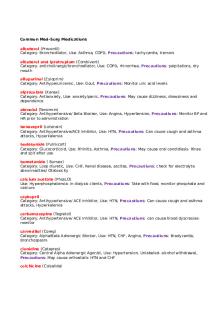
Common Med Surg Meds
- 7 Pages

Med surg dorris bowman
- 4 Pages
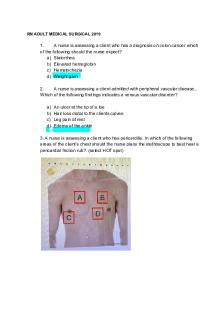
Med surg - notes
- 28 Pages
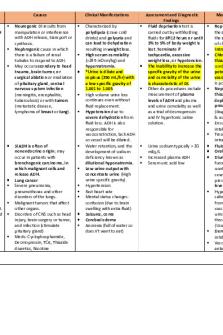
Med-Surg Endocrine
- 11 Pages
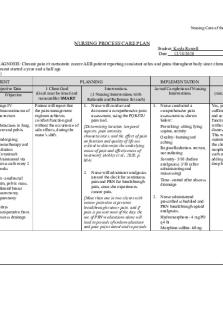
Med Surg- Care Plan
- 6 Pages
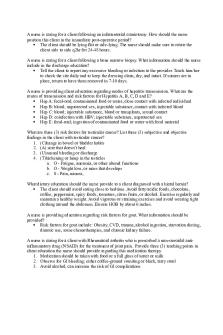
Med-Surg Capstone remediation
- 4 Pages

Med Surg Exam 3
- 19 Pages
Popular Institutions
- Tinajero National High School - Annex
- Politeknik Caltex Riau
- Yokohama City University
- SGT University
- University of Al-Qadisiyah
- Divine Word College of Vigan
- Techniek College Rotterdam
- Universidade de Santiago
- Universiti Teknologi MARA Cawangan Johor Kampus Pasir Gudang
- Poltekkes Kemenkes Yogyakarta
- Baguio City National High School
- Colegio san marcos
- preparatoria uno
- Centro de Bachillerato Tecnológico Industrial y de Servicios No. 107
- Dalian Maritime University
- Quang Trung Secondary School
- Colegio Tecnológico en Informática
- Corporación Regional de Educación Superior
- Grupo CEDVA
- Dar Al Uloom University
- Centro de Estudios Preuniversitarios de la Universidad Nacional de Ingeniería
- 上智大学
- Aakash International School, Nuna Majara
- San Felipe Neri Catholic School
- Kang Chiao International School - New Taipei City
- Misamis Occidental National High School
- Institución Educativa Escuela Normal Juan Ladrilleros
- Kolehiyo ng Pantukan
- Batanes State College
- Instituto Continental
- Sekolah Menengah Kejuruan Kesehatan Kaltara (Tarakan)
- Colegio de La Inmaculada Concepcion - Cebu


